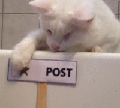|
honda whisperer posted:Yes thick goes on top. Thick end goes on top for sure. That tool also looks dull or has buildup on the top edge. Hard to tell from the picture. I find that lubrication/coolant is necessary for parting in aluminum and steel. I cut brass and cast iron dry. Parting tools need to be on or _above_ center. If you are below center the tool will tend to pull into the work and break. I run my parting tools 0.004" to 0.008" above center in 99% of the cases. Parting really small stuff would be where I would try to get the tool exactly on center.
|
|
|
|

|
| # ? May 23, 2024 17:33 |
|
ZincBoy posted:Thick end goes on top for sure. That tool also looks dull or has buildup on the top edge. Hard to tell from the picture. Did not know that about it needing to be above center, learned something new today! And to me, it looks like that cutting edge is so dull it almost looks like a big ole radius instead of a sharp edge, but yes, it's hard to tell from the picture.
|
|
|
|
Yooper posted:Educate me here, Google brings up a lot of different "knife vise". that rules, where is a buy link OTOH holy poo poo would that be a pain in the rear end to set up
|
|
|
Kenshin posted:that rules, where is a buy link https://knifemaking.com/collections/vises/products/pv622-knifemakers-contour-vise Yah, set up looks like a pain.
|
|
|
|
|
does anyone know what those quick release spring nuts that dividers and compasses have are named and where I can buy them in bulk in like M4 or M5 thread?
|
|
|
|
shame on an IGA posted:does anyone know what those quick release spring nuts that dividers and compasses have are named and where I can buy them in bulk in like M4 or M5 thread? Are you talking about cage nuts?  Those are commonly used in computer/audio racks and the most common size is M5. You can get them pretty cheap in bulk pretty much anywhere that sells computer stuff. E: lol, no you aren't, this is the blacksmithing and metalworking thread. Motronic fucked around with this message at 23:07 on Jun 2, 2021 |
|
|
|
ZincBoy posted:Thick end goes on top for sure. That tool also looks dull or has buildup on the top edge. Hard to tell from the picture. Yes, it is a bit dull and could use some sharpening, but I was having the same problems fresh out of the box. It's been a long time since I used the parting tool, but it is doing exactly what you describe by pulling into the work (towards the chuck) so I'll try sharpening it and shipping it up above the centerline and see how that goes. I'm pretty sure I checked the cross slide to make sure it was square to the work, but I'll check that again as well. I've been using in on brass and plastic mainly, but I do use lubricant when working aluminum.
|
|
|
|
shame on an IGA posted:does anyone know what those quick release spring nuts that dividers and compasses have are named and where I can buy them in bulk in like M4 or M5 thread? I think you're talking about "push button nuts" not sure about sourcing mcmaster doesn't have metric msc has metric but they don't go below m6.
|
|
|
|
hey why does kemppi not sell in the united states? what the hell
|
|
|
|
SkunkDuster posted:Yes, it is a bit dull and could use some sharpening, but I was having the same problems fresh out of the box. It's been a long time since I used the parting tool, but it is doing exactly what you describe by pulling into the work (towards the chuck) so I'll try sharpening it and shipping it up above the centerline and see how that goes. I'm pretty sure I checked the cross slide to make sure it was square to the work, but I'll check that again as well. I've been using in on brass and plastic mainly, but I do use lubricant when working aluminum. A dull parting tool will be an exercise in frustration. Also, those blades are often not sharp from the factory. I had a few of them before I switched to inserts and they needed sharpening before use. You need to make sure the blade is sharpened square to the work as well. If it is on an angle, the blade will pull in that direction and create a tapered parting surface. Putting the tool above centerline is largely to prevent it from going below center when deflected by cutting forces. This is critical on a flexible machine like the mini lathes. I would also recommend against going to inserts for parting on a mini lathe. Carbide inserts need to run at least 0.004ipr and preferably 0.006 to 0.008. This is due to the insert only really cutting when the DOC is greater than the flat on the nose. Less that that DOC and you are just rubbing and you will get a ton of chatter and inconsistent feeding. With a sharp HSS blade you can take very shallow DOC and keep in the HP/stiffness capability of the mini lathe.
|
|
|
|
A 50S RAYGUN posted:hey why does kemppi not sell in the united states? what the hell Probably a difficult market to get into. In the 90s you'd sometimes find rebadged kemppis though under the powcon brand.
|
|
|
|
SkunkDuster posted:Been a long weekend, so sorry for the delay. I checked the vertical orientation with a square and it seems to be completely vertical, so my guess is that my cross slide isn't square to the workpiece. Maybe a dumb question, but I do I have the parting tool installed correctly with the thick side on top (leading edge)? Ah, that's a T shaped parting tool, you might need to shim it on the lower section. This is a good vid on setting up a small lathe for parting, she covers the different types of tools. https://www.youtube.com/watch?v=PeHmee4tvYc
|
|
|
|
echomadman posted:Ah, that's a T shaped parting tool, you might need to shim it on the lower section. Thanks for the link! I learned quite a bit from it. I assumed the tool holder was angled to compensate for the thicker edge of the T-shaped parting tool, but now I'm going to put it in my milling machine and check it with a dial indicator. If it isn't perpendicular to the base of the tool holder, I'll mill a relief to get it square.
|
|
|
|
CommonShore posted:What's this weird little hammer for Tool thread thinks it's for shaping sheet metal but told me to double check here.
|
|
|
|
CommonShore posted:Tool thread thinks it's for shaping sheet metal but told me to double check here. Iíve seen similar ones used by cobblers and saddlers.
|
|
|
|
Vindolanda posted:I’ve seen similar ones used by cobblers and saddlers. I googled #2 cobbler hammer. E: looks like you'll have to Google it yourself if the images aren't showing up https://thumbs.worthpoint.com/zoom/images2/1/0313/03/witcher-crispin-cobbler-shoemaker_1_d0953dbd27670f428fc89cf64abee2a1.jpg https://i0.wp.com/workingtools.biz/wp-content/uploads/2020/06/P6075963.jpg?fit=350%2C263&ssl=1 https://thumbs.worthpoint.com/zoom/images2/1/0412/12/whitcher-boston-antique-cobblers_1_c535b409ba5796699af21c2b56ee39ee.jpg MisterOblivious fucked around with this message at 10:52 on Jun 5, 2021 |
|
|
|
MisterOblivious posted:I googled #2 cobbler hammer. Hey hey! Thanks!
|
|
|
|
Clean metal finishes for optical assemblies I need some suggestions for finishes for aluminum and steel that are clean. What I mean is no oil film, no rust, and clean to the touch. Something I can scrub with hot water and dish detergent, let dry, and handle with grubby fingers, and not get any sort of corrosion or staining. Environment is a normal office. I really like passivated stainless and anodized aluminum. I don't like anodizing changing dimensions on my holes. What other finishes should I look at. How does alodine feel to the touch, is it pretty clean? Is there anything I can put on 12L14 or mild steel to make it nice to handle, without the thickness of powder coat or paint? I have some black oxide 18-8 stainless screws that feel nice. Does anyone know what coating this is? I don't know a lot about metal finishing, so I'm mostly looking for ideas.
|
|
|
|
ryanrs posted:I have some black oxide 18-8 stainless screws that feel nice. Does anyone know what coating this is? If I had to guess, I'd say it is black oxide.
|
|
|
ryanrs posted:Clean metal finishes for optical assemblies Carburizing might give you something on 12L14. Nitriding would be nice, but 12L14 won't nitride. You could also look at parkerizing (phosphate conversion), it's what they do on gun parts for example. There are a few different types of anodizing, I've only had it done for wear resistance so we want a thick coating. I also just chase the threads after process.
|
|
|
|
|
I like protectaclear for that. It goes on like paint but is very thin, durable, and easy to get.
|
|
|
|
Thanks! Protectaclear seems like a useful thing to have around the office. I guess I should mention that I'm not a machinist or a metal finisher, I just need some parts made. My next step is to talk to a machinist about my part and finishing options. I sort of expect the machinist will then farm out the finishing to another shop they know if it's plating or anodizing, etc. I'm pretty new to designing/buying machined parts. I have another part coming up that will have about 50 threaded holes (1/4-20 and M5) in an aluminum 12x24x0.25" plate. I really want a black type 2 anodize, but I also want nice threads. The order will be for 3-5 plates. How is this usually handled? A second pass with taps, or masking the threaded holes? What about precision plain holes for dowel pins and similar? (I hope these kind of questions are welcome here. I'm trying to not design stupid parts.)
|
|
|
ryanrs posted:Thanks! Protectaclear seems like a useful thing to have around the office. If it's easy enough to reclamp the part then I would just have them chase the holes after anodizing. Depending on tolerancing I'd do the finish reamed holes after surface finishing. You could mask them, but I've seen a slight "shoulder" when that's done. It all depends on how your datum is set and the reference between the holes.
|
|
|
|
|
We mask tapped and dowel holes for anodizing by default. Our drawing notes requires the anodizer to do it.
|
|
|
|
If I'm getting a small batch of parts anodized (like 5 small parts each under 10 sq in), and I want a color other than black, how is that done? Is it something easy where my couple parts get dunked in a separate bucket of dye, or does it involve a big setup and lots of cost? Instead of some pantone number or whatever, can my spec be "any bright/bold color red, orange, green, blue" and then hitch a ride on a larger anodizing run? Does this make my tiny orders less of a hassle/cheaper, or does it just confuse the process because I'm not being precise about what I want? This is for internal parts/tooling where the color doesn't matter and I think a bright color would look nice or be easier to find on my bench, etc.
|
|
|
|
Depends on who's doing the job for you, some places won't take anything other than a precise order, others will be happy to throw your parts in with a bigger job at zero cost to them. I once sent a tool to be blasted and painted for a training mock up and told them "this needs to be somewhere between white and black, those needs to be some shade of blue" and got the job done for about 10% of expected cost because they were able to use dregs and scraps instead of having to pay to dispose of them properly.
|
|
|
|
If you're in an area with any decent amount of manufacturing, there's most likely a plater around who will be able to let it go in with other stuff, especially if you are not picky about delivery times.
|
|
|
|
Tried making a stand for my blacksmith post vise:   It's gonna so drat useful to have a vise outdoors so I can do angle grinder stuff outside.
|
|
|
|
ryanrs posted:Thanks! Protectaclear seems like a useful thing to have around the office. Any decent machine shop will have oversized taps for anodizing. I've designed, ordered, and used thousands of aluminum parts with anodized threads and never had issues except where the plater or machinist screwed up. Very small and deep holes can have problems in anodizing because of bubble formation, but you can always call it out on the drawing. You can always also mask the tapped holes if you want. None of this is uncommon. Dowel pins get masked or you can use custom pins with a 1/2 grind. Type 2 won't hold up to dowel pin pressures, so I'd mask them. Note that you'll need to call out the tolerances on any precision holes. I get the feeling that you're not experienced with this, so I'd suggest talking to an engineer or working with your machine shop to make things work out correctly the first time. Hell, you could even post your drawings or parts of them here, and we'll chime in to assist.
|
|
|
|
Yooper posted:You could also look at parkerizing (phosphate conversion), it's what they do on gun parts for example. Parkerizing requires oiling, so that's out. It doesn't prevent rust on its own, it creates a porous surface that soaks up oil. If you don't oil it, it'll soak up your skin oil, acids and salt instead.
|
|
|
|

|
|
|
|
I want it
|
|
|
|
some more  honestly a handful of those would be pretty useful. DIN 911 in particular Sagebrush fucked around with this message at 17:23 on Jun 7, 2021 |
|
|
|
goddamn, i honestly assumed those were a put-on or at least an old-hand manual machinist's gently caress-around project are these things you can actually purchase/do these get any use at all, or are they just there so sadists can spec them in a design as a means to give the recipient a brain embolism
|
|
|
|
I'm pretty sure that the SW17 on a bunch of those stands for solidworks 2017, I think it's a demo/marketing from Dassault.
|
|
|
|
Lmao, is there one for nuts too?
|
|
|
|
Didn't This Old Tony make a wrench for turning two bolts at the same time?
|
|
|
 Friend of mine welds at a local shipyard that makes barges for the US Gov't. They ran into an issue where someone forgot a weld inside the barge, so instead of crawling in with all of the welding equipment they sent in the skinniest guy with a tube of caulk and a can of spray paint.
|
|
|
|
|
Bet you got to be pretty skilled to run a stack of dimes with a caulk gun though
|
|
|
|

|
| # ? May 23, 2024 17:33 |
|
I've seen din 910's as screws rather than bolts and are commonly shipped with drawer handles and other things where the thickness of the material that the handle will be attached to are not known before hand.
|
|
|





































